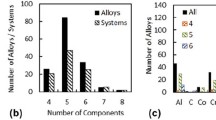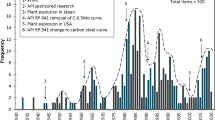Abstract
Steam oxidation experiments were conducted at 800–1400 °C with boiling water reactor alloy Zircaloy-2 strip specimens. Sample weight gain measurements were performed on the oxidized specimens before and after the test and were compared to oxygen pickup calculations using the Cathcart–Pawel correlation. The results showed that Zircaloy-2 follows the parabolic law at temperatures above 1000 °C. At or below 1000 °C, the oxidation rate was very low when compared to Cathcart–Pawel correlation and can be represented by a cubic expression. Arrhenius expressions are given to describe the parabolic rate constants at temperatures above 1000 °C and cubic rate constants are provided for temperatures at or below 1000 °C. The weight gains calculated by our Arrhenius correlations are in excellent agreement with the measured sample weight gains at all test temperatures.






Similar content being viewed by others
References
L. Baker and L. C. Just, Studies of Metal-Water Reactions at High Temperatures; III. Experimental and Theoretical Studies of the Zirconium-Water Reaction, ANL-6548, May 1962.
J. V. Cathcart, R. E. Pawel, R. A. McKee, R. E. Druschel, G. J. Yurek, J. J. Cambell, and S. H. Jury, Zirconium Metal-Water Oxidation Kinetics IV. Reaction Rate Studies, ORNL/NUREG-17, Aug. 1977.
U.S. Nuclear Regulatory Commission, Office of Nuclear Regulatory Research, DG-1262 Testing for Postquench Ductility," ML111100368, 2011.
Garde, A. M., Comstock, R. J., Pan, G., Baranwal, R., Hallstadius, L., Cook, T., and Carrera, F., Advanced zirconium alloy for PWR application, J. ASTM Intl., Vol. 7, No. 9, 2010, doi: https://doi.org/10.1520/JAI103030.
S. Leistikow and G. Schanz, Kinetics and morphology of isothermal steam oxidation of Zircaloy-4 at 700–1300C, KFK 2587, March 1978.
H. M. Chung and T. F. Kassner, Journal of Nuclear Materials 84, 1979 (327).
Y. Yan, R. V. Strain, T. S. Bray, and M. C. Billone, High Temperature Oxidation of Irradiated Limerick BWR Cladding, NUREG/CP-0176 (May 2002) pp. 353–372.
F. Nagase, T. Otomo, and H. Uetsuka, Journal of Nuclear Science & Technology 40, 2003 (213).
J.-P. Mardon, D. Charquet, and J. Senevat, Influence of Composition and Fabrication Process on Out-of-Pile and In-Pile Properties of M5 Alloy, Zirconium in the Nuclear Industry: 12th International Symposium, ASTM STP 1354, G. P. Sabol and G. D. Moan, Eds., American Society for Testing and Materials, West Conshohocken, PA, (2000) pp. 505–524.
Y. Yan, T. Burtseva, and M. C. Billone, LOCA Results for Advanced-Alloy and High-Burnup Zircaloy Cladding, NUREG/CP-0185 (June 2004) pp. 97–121.
M. Billone, Y. Yan, T. Burtseva, and R. Daum, Cladding Embrittlement During Postulated Loss-of-Coolant Accidents, NUREG/CR-6967; ANL-07/04 (July 2008).
R. J. Comstock, G. Schoenberger, and G. P. Sabol, Influence of Processing Variables and Alloy Chemistry on the Corrosion Behavior of ZIRLO Nuclear Fuel Cladding, Zirconium in the Nuclear Industry: 11th International Symposium, ASTM STP 1295, E. R. Bradley and G. P. Sabol, Eds., American Society for Testing and Materials (1996) pp. 710–725.
P. V. Shebaldov, M. M. Peregud, A. V. Nikulina, Y. K. Bibilashvilli, A. F. Lositski, N. V. Kuz’menko, V. I. Belov, and A. E. Novoselov, E1110 Alloy Cladding Tube Properties and Their Interrelation with Alloy Structure-Phase Condition and Impurity Content, Zirconium in the Nuclear Industry: 12thInternational Symposium, ASTM STP 1354, G. P. Sabol and G. D. Moan, Eds., American Society for Testing and Materials, West Conshohocken, PA (2000) pp. 545–559.
L. Yegorova, K. Lioutov, N. Jouravkova, A. Konobeev, V. Smirnov, V. Chesanov, and A. Goryachev, Experimental Study of Embrittlement of Zr-1%Nb VVER Cladding under LOCA-Relevant Conditions, NUREG/IA-0211 (Mar. 2005).
Y. Yan, T. Burtseva, and M. Billone, Journal of Nuclear Material 393, 2009 (433).
V. Vrtílková, S. Linhart, and L. Novotný. Corrosion and thermo-mechanical properties of E110 alloys. Proceedings of Nuclear Fuel Workshop, Liberec, Czech Republic, 27–30 April, 2009.
M. Kiraly, K. Kulacsy, Z. Hozer, E. Perez-Fero, and T. Novotny, Journal of Nuclear Material 475, 2016 (27).
Y. Yan, B. E. Garrison, M. Howell, and G. L. Bell, Journal of Nuclear Material 499, 2018 (595).
J. Krejčí, V. Vrtílková, P. Gajdoš, and D. Rada, Nuclear Science and Technology 3, 2017 (18).
Y. Yan, J. R. Keiser, K. A. Terrani, G. L. Bell, and L. L. Snead, Journal of Nuclear Materials 448, 2014 (436).
Author information
Authors and Affiliations
Corresponding author
Additional information
Publisher's Note
Springer Nature remains neutral with regard to jurisdictional claims in published maps and institutional affiliations.
This manuscript was authored by UT-Battelle, LLC, under contract DE-AC05-00OR22725 with the US Department of Energy (DOE). The US government retains and the publisher, by accepting the article for publication, acknowledges that the US government retains a nonexclusive, paid-up, irrevocable, worldwide license to publish or reproduce the published form of this manuscript, or allow others to do so, for US government purposes. DOE will provide public access to these results of federally sponsored research in accordance with the DOE Public Access Plan (http://energy.gov/downloads/doe-public-access-plan).
Appendix A: Weight Gain Correlations for Zircaloy-4, E110, and Zircaloy-2
Appendix A: Weight Gain Correlations for Zircaloy-4, E110, and Zircaloy-2
Weight gain correlation for PWR alloy Zircaloy-4 by Cathcart and Pawel [2]:
where Wg is weight gain in g/cm2, T is temperature in K, and t is time in s.
Weight gain correlations for PWR alloy E110 by Yan et al. [18]:
where Wg is weight gain in g/cm2, T is temperature in K, and t is time in s.
Weight gain correlations for BWR alloy Zircaloy-2 in this work:
where Wg is weight gain in g/cm2, T is temperature in K, and t is time in s.
Rights and permissions
About this article
Cite this article
Yan, Y., Garrison, B.E., T. Nelson, A. et al. Correlations of the Steam Oxidation Rate Constant of BWR Alloy Zircaloy-2 at 800–1400 °C. Oxid Met 97, 227–239 (2022). https://doi.org/10.1007/s11085-021-10070-7
Received:
Revised:
Accepted:
Published:
Issue Date:
DOI: https://doi.org/10.1007/s11085-021-10070-7




